Methods of Manipulation of Acoustic Radiation Using Metamaterials with a Focus on Polymers: Design and Mechanism Insights
Abstract
1. Introduction
2. Coordinate Transformation Methods for Wave Variation and Conditioning
2.1. Electromagnetic Waves
2.2. Sound Waves
2.2.1. Multi-Region Division of Objects
2.2.2. Medium Conditioning
3. The Acoustic Properties of Sound Waves Are Influenced by the Regulation of Polymer Acoustic Metamaterials
3.1. Frequency Manipulation
3.2. Phase Manipulation
3.3. Scatter Manipulation
4. Conclusions and Prospectives
- (1)
- Structural design issues: The precise manipulation function of acoustic waves depends on the structural design of polymer acoustic metamaterials. By combining the structural transformation capabilities of the coordinate transformation methods, polymer metamaterials’ structures can be designed and optimized with specific shapes, periodicities, and geometrical parameters to achieve precise control of acoustic waves. Such designs must be optimized to achieve the desired results.
- (2)
- Medium tuning issues: The properties of polymer acoustic metamaterials are affected by the material parameters, so tuning the medium parameters can change the acoustic properties and enable more precise tuning of acoustic waves. Using the coordinate transformation methods’ medium adjustment capability, it is possible to design and adjust the medium parameters of polymer acoustic metamaterials, such as acoustic impedance, density, modulus, and acoustic transmittance. This allows frequency selectivity and phase manipulation of acoustic waves to be achieved.
- (3)
- Practical application issues: The real use environment of polymer acoustic metamaterials is usually complex and changeable. The long-term stability, durability and performance in the complex environments of polymers need to be considered comprehensively. The future development direction needs to focus on improving the frequency response range of polymers, optimizing their sound absorption and acoustic control efficiency, and exploring new functional applications to promote the wide application and commercial development of polymer acoustic metamaterials.
Author Contributions
Funding
Institutional Review Board Statement
Data Availability Statement
Conflicts of Interest
References
- Assouar, B.; Liang, B.; Wu, Y.; Li, Y.; Cheng, J.C.; Jing, Y. Acoustic metasurfaces. Nat. Rev. Mater. 2018, 3, 460–472. [Google Scholar] [CrossRef]
- Chen, Y.Y.; Huang, G.L.; Zhou, X.M.; Hu, G.K.; Sun, C.T. Analytical coupled vibroacoustic modeling of membrane-type acoustic metamaterials: Membrane model. J. Acoust. Soc. Am. 2014, 136, 969–979. [Google Scholar] [CrossRef]
- Chiariotti, P.; Martarelli, M.; Castellini, P. Acoustic beamforming for noise source localization-Reviews, methodology and applications. Mech. Syst. Sig. Process 2019, 120, 422–448. [Google Scholar] [CrossRef]
- Cummer, S.A.; Christensen, J.; Alù, A. Controlling sound with acoustic metamaterials. Nat. Rev. Mater. 2016, 1, 16001. [Google Scholar] [CrossRef]
- Ding, X.; Zhao, Y.C.; Yan, D.; Zhang, K. Controllable propagation of bending waves in wrinkled films. J. Appl. Mech T ASME 2019, 86, 061005. [Google Scholar] [CrossRef]
- Ge, H.; Yang, M.; Ma, C.; Lu, M.H.; Chen, Y.F.; Fang, N.; Sheng, P. Breaking the barriers: Advances in acoustic functional materials. Natl. Sci. Rev. 2018, 5, 159–182. [Google Scholar] [CrossRef]
- Latifi, K.; Kopitca, A.; Zhou, Q. Model-free control for dynamic-field acoustic manipulation using reinforcement learning. IEEE Access 2020, 8, 20597–20606. [Google Scholar] [CrossRef]
- Liang, X.; Du, J.B. Concurrent multi-scale and multi-material topological optimization of vibro-acoustic structures. Comput. Methods Appl. Mech. Eng. 2019, 349, 117–148. [Google Scholar] [CrossRef]
- Yang, J.; Wu, M.; Han, L. A Review of Sound Field Control. Appl. Sci. 2022, 12, 7319. [Google Scholar] [CrossRef]
- Yang, S.J.; Tian, Z.H.; Wang, Z.Y.; Rufo, J.; Li, P.; Mai, J.; Xia, J.P.; Bachman, H.; Huang, P.H.; Wu, M.X.; et al. Harmonic acoustics for dynamic and selective particle manipulation. Nat. Mater. 2022, 21, 540–546. [Google Scholar] [CrossRef]
- Zhu, R.; Liu, X.N.; Hu, G.K.; Sun, C.T.; Huang, G.L. A chiral elastic metamaterial beam for broadband vibration suppression. J. Sound Vib. 2014, 333, 2759–2773. [Google Scholar] [CrossRef]
- Baudoin, M.; Thomas, J.L. Acoustic tweezers for particle and fluid micromanipulation. Annu. Rev. Fluid Mech. 2020, 52, 205–234. [Google Scholar] [CrossRef]
- Gao, Y.; Fajrial, A.K.; Yang, T.; Ding, X.Y. Emerging on-chip surface acoustic wave technology for small biomaterials manipulation and characterization. Biomater. Sci. 2021, 9, 1574–1582. [Google Scholar] [CrossRef]
- Guex, A.G.; Di Marzio, N.; Eglin, D.; Alini, M.; Serra, T. The waves that make the pattern: A review on acoustic manipulation in biomedical research. Mater. Today Bio 2021, 10, 100110. [Google Scholar] [CrossRef]
- Li, B.; Peng, Z.L.; Wen, H.B.; Fan, J.; Song, H. Research on the optimization design of acoustic stealth shape of the underwater vehicle head. Acoust. Aust. 2020, 48, 39–47. [Google Scholar] [CrossRef]
- Peng, D.L.; Tong, W.; Collins, D.J.; Ibbotson, M.R.; Prawer, S.; Stamp, M. Mechanisms and applications of neuromodulation using surface acoustic waves-a mini-review. Front. Neurosci. 2021, 15, 629056. [Google Scholar] [CrossRef]
- Saeed, N.; Celik, A.; Al-Naffouri, T.Y.; Alouini, M.S. Underwater optical wireless communications, networking, and localization: A survey. Ad Hoc Netw. 2019, 94, 101935. [Google Scholar] [CrossRef]
- Sutin, A.M.; Salloum, H. Interaction of acoustic and electromagnetic waves in nondestructive evaluation and medical applications. Radiophys. Quantum Electron. 2020, 63, 40–54. [Google Scholar] [CrossRef]
- Tang, Y.H.; Wang, X.R.; Miao, X.H.; Gao, S.Y.; Li, B.; Peng, Z.L. Optimum design of acoustic stealth shape of underwater vehicle model with conning tower. Front. Phys. 2023, 11, 1105787. [Google Scholar] [CrossRef]
- Zhang, K.; Ma, C.; He, Q.; Lin, S.T.; Chen, Y.; Zhang, Y.; Fang, N.X.; Zhao, X.H. Metagel with broadband tunable acoustic properties over air-water-solid ranges. Adv. Funct. Mater. 2019, 29, 1903699. [Google Scholar] [CrossRef]
- Huang, H.Y.; Cao, E.R.; Zhao, M.Y.; Alamri, S.; Li, B. Spider web-inspired lightweight membrane-type acoustic metamaterials for broadband low-frequency sound isolation. Polymers 2021, 13, 1146. [Google Scholar] [CrossRef]
- Merillas, B.; Villafañe, F.; Rodríguez-Pérez, M.A. A new methodology based on cell-wall hole analysis for the structure-acoustic absorption correlation on polyurethane foams. Polymers 2022, 14, 1807. [Google Scholar] [CrossRef]
- Yang, X.C.; Tang, S.; Shen, X.M.; Peng, W.Q. Research on the sound insulation performance of composite rubber reinforced with hollow glass microsphere based on acoustic finite element simulation. Polymers 2023, 15, 611. [Google Scholar] [CrossRef]
- Yousry, Y.M.; Statharas, E.C.; Yao, K.; Mohamed, A.M.; Lim, P.C.; Tay, F.E.H. Sound absorption improvement in porous ferroelectret polyethylene with effective piezoelectric mechanism. Polymers 2022, 14, 4843. [Google Scholar] [CrossRef]
- Monkova, K.; Vasina, M.; Monka, P.P.; Vanca, J.; Kozak, D. Effect of 3D-printed PLA structure on sound reflection properties. Polymers 2022, 14, 413. [Google Scholar] [CrossRef]
- Zhou, Y.; Chen, J.; Chen, R.; Chen, W.J.; Fan, Z.; Ma, Y.G. Ultrathin electromagnetic-acoustic amphibious stealth coats. Adv. Opt. Mater. 2020, 8, 2000200. [Google Scholar] [CrossRef]
- Veselago, V.G. The electrodynamics of substances with simultaneously negative values of ε and μ. Phys. Usp. 1968, 10, 509–514. [Google Scholar] [CrossRef]
- Schurig, D.; Mock, J.J.; Justice, B.J.; Cummer, S.A.; Pendry, J.B.; Starr, A.F.; Smith, D.R. Metamaterial electromagnetic cloak at microwave frequencies. Science 2006, 314, 977–980. [Google Scholar] [CrossRef]
- Baz, A. Active acoustic metamaterial with tunable effective density using a disturbance rejection controller. J. Appl. Phys. 2019, 125, 074503. [Google Scholar] [CrossRef]
- Choi, J.S.; Yoon, G.H. Acoustic metamaterials with combined heterogeneous double-split hollow sphere for noise reduction. J. Vib. Control 2018, 24, 4933–4944. [Google Scholar] [CrossRef]
- Gao, N.S.; Zhang, Z.C.; Deng, J.; Guo, X.Y.; Cheng, B.Z.; Hou, H. Acoustic metamaterials for noise reduction: A review. Adv. Mater. Technol. 2022, 7, 2100698. [Google Scholar] [CrossRef]
- Huang, X.C.; Su, Z.W.; Zhang, Z.G.; Hua, H.X. Mechanism of a periodic chiral lattice coating on sound radiation suppression at the strong radiation mode of a stiffened hull plate. Int. J. Mech. Sci. 2020, 175, 105512. [Google Scholar] [CrossRef]
- Lan, J.; Liu, Y.P.; Wang, T.; Li, Y.F.; Liu, X.Z. Acoustic coding metamaterial based on non-uniform Mie resonators. Appl. Phys. Lett. 2022, 120, 163501. [Google Scholar] [CrossRef]
- Lee, K.H.; Yu, K.; Al Ba’ba’a, H.; Xin, A.; Feng, Z.Z.R.; Wang, Q.M. Sharkskin-inspired magnetoactive reconfigurable acoustic metamaterials. Research 2020, 2020, UNSP4825185. [Google Scholar] [CrossRef]
- Liu, B.Y.; Su, Z.X.; Zeng, Y.; Wang, Y.T.; Huang, L.L.; Zhang, S. Acoustic geometric-phase meta-array. New J. Phys. 2021, 23, 113026. [Google Scholar] [CrossRef]
- Zhang, Q.; Zhang, K.; Hu, G.K. Tunable fluid-solid metamaterials for manipulation of elastic wave propagation in broad frequency range. Appl. Phys. Lett. 2018, 112, 221906. [Google Scholar] [CrossRef]
- Liu, Z.Y.; Zhang, X.X.; Mao, Y.W.; Zhu, Y.Y.; Yang, Z.Y.; Chan, C.T.; Sheng, P. Locally resonant sonic materials. Science 2000, 289, 1734–1736. [Google Scholar] [CrossRef]
- Fang, N.; Xi, D.J.; Xu, J.Y.; Ambati, M.; Srituravanich, W.; Sun, C.; Zhang, X. Ultrasonic metamaterials with negative modulus. Nat. Mater. 2006, 5, 452–456. [Google Scholar] [CrossRef]
- Chen, Z.; Guan, S.H.; Xie, Q.; Li, Z.; Gao, Z.M.; Negahban, M. Locally resonant metasurface for low-frequency transmissive underwater acoustic waves. Front. Phys. 2023, 10, 1098261. [Google Scholar] [CrossRef]
- Chi, M.X.; Chen, S.B.; Jiao, J.N.; Yu, N. Real-time acoustic energy harvesting in tunable frequencies via metasurface fabricated by additive manufacturing. J. Appl. Phys. 2023, 133, 245105. [Google Scholar] [CrossRef]
- Kim, J.W.; Yoon, G.H. Structural optimization scheme for acoustic cloaking structures considering general surfaces. Eng. Optim. 2021, 54, 651–664. [Google Scholar] [CrossRef]
- Liang, T.B.; He, M.; Dong, H.W.; Xia, L.; Huang, X.D. Ultrathin waterborne acoustic metasurface for uniform diffuse reflections. Mech. Syst. Sig. Process. 2023, 192, 110226. [Google Scholar] [CrossRef]
- Xie, Y.B.; Wang, W.Q.; Chen, H.Y.; Konneker, A.; Popa, B.I.; Cummer, S.A. Wavefront modulation and subwavelength diffractive acoustics with an acoustic metasurface. Nat. Commun. 2014, 5, 5553. [Google Scholar] [CrossRef] [PubMed]
- Zhu, H.F.; Semperlotti, F. Anomalous refraction of acoustic guided waves in solids with geometrically tapered metasurfaces. Phys. Rev. Lett. 2016, 117, 034302. [Google Scholar] [CrossRef]
- Yu, N.F.; Genevet, P.; Kats, M.A.; Aieta, F.; Tetienne, J.P.; Capasso, F.; Gaburro, Z. Light propagation with phase discontinuities: Generalized laws of reflection and refraction. Science 2011, 334, 333–337. [Google Scholar] [CrossRef]
- Pendry, J.B.; Schurig, D.; Smith, D.R. Controlling electromagnetic fields. Science 2006, 312, 1780–1782. [Google Scholar] [CrossRef]
- Leonhardt, U. Optical conformal mapping. Science 2006, 312, 1777–1780. [Google Scholar] [CrossRef]
- Dai, H.J.; Zhang, X.T.; Zheng, Y.J.; Pei, W.R.; Zhou, R.G.; Liu, R.; Gong, Y. Review and prospects of metamaterials used to control elastic waves and vibrations. Front. Phys. 2022, 10, 1069454. [Google Scholar] [CrossRef]
- Kim, K.H.; Yoon, G.H. Acoustic topology optimization using moving morphable components in neural network-based design. Struct. Multidiscip. Optim. 2022, 65, 47. [Google Scholar] [CrossRef]
- Li, Z.Y.; Hou, X.Y.; Ke, Y.B.; Tao, M. Topology optimization with a genetic algorithm for the structural design of composite porous acoustic materials. Appl. Acoust. 2022, 197, 108917. [Google Scholar] [CrossRef]
- Shen, J.H.; Lee, H.P.; Yan, X. Sound absorption performance and mechanism of flexible PVA microperforated membrane. Appl. Acoust. 2022, 185, 108420. [Google Scholar] [CrossRef]
- Zhang, X.P.; Xing, J.; Liu, P.; Luo, Y.J.; Kang, Z. Realization of full and directional band gap design by non-gradient topology optimization in acoustic metamaterials. Extrem. Mech. Lett. 2021, 42, 101126. [Google Scholar] [CrossRef]
- Zhao, W.C.; Chen, L.L.; Chen, H.B.; Marburg, S. An effective approach for topological design to the acoustic-structure interaction systems with infinite acoustic domain. Struct. Multidiscip. Optim. 2020, 62, 1253–1273. [Google Scholar] [CrossRef]
- Chen, H.Y. Transformation optics in orthogonal coordinates. J. Opt. A Pure Appl. Opt. 2009, 11, 075102. [Google Scholar] [CrossRef]
- Zhang, L.; Chen, X.Q.; Shao, R.W.; Dai, J.Y.; Cheng, Q.; Castaldi, G.; Galdi, V.; Cui, T.J. Breaking reciprocity with space-time-coding digital metasurfaces. Adv. Mater. 2019, 31, 1904069. [Google Scholar] [CrossRef] [PubMed]
- Chamanara, N.; Deck-Léger, Z.L.; Caloz, C.; Kalluri, D. Unusual electromagnetic modes in space-time-modulated dispersion-engineered media. Phys. Rev. A 2018, 97, 063829. [Google Scholar] [CrossRef]
- Tao, S.C.; Chen, H.Y. Absorption characteristics of perfect absorber, electromagnetic “black hole” and inner perfectly matched layer. Acta. Phys. Sin. 2020, 69, 154201. [Google Scholar] [CrossRef]
- Sidhwa, H.H.; Aiyar, R.P.R.C.; Kavehvash, Z. Cloaking of irregularly shaped bodies using coordinate transformation. Optik 2019, 197, 163201. [Google Scholar] [CrossRef]
- Xu, L.; Chen, H.Y. Transformation metamaterials. Adv. Mater. 2021, 33, 2005489. [Google Scholar] [CrossRef]
- Fakheri, M.H.; Abdolali, A. Application of transformation optics in radar cross section reduction of targets with arbitrary two-dimensional geometries. J. Appl. Phys. 2019, 125, 234901. [Google Scholar] [CrossRef]
- Xu, J.W.; Mai, W.D.; Werner, D.H. Generalized temporal transfer matrix method: A systematic approach to solving electromagnetic wave scattering in temporally stratified structures. Nanophotonics 2022, 11, 1309–1320. [Google Scholar] [CrossRef]
- Kadic, M.; Bückmann, T.; Schittny, R.; Wegener, M. Metamaterials beyond electromagnetism. Rep. Prog. Phys. 2013, 76, 126501. [Google Scholar] [CrossRef]
- Zhou, Y.; Chen, J.; Liu, L.; Fan, Z.; Ma, Y.G. Magnetic-acoustic biphysical invisible coats for underwater objects. NPG Asia Mater. 2020, 12, 27. [Google Scholar] [CrossRef]
- Li, P.F.; Yang, F.; Wang, P.; Zhao, J.F.; Zhong, Z. A novel design scheme for acoustic cloaking of complex shape based on region partitioning and multi-origin coordinate transformation. Appl. Math. Mech. 2022, 43, 1641–1656. [Google Scholar] [CrossRef]
- Zhu, J.; Chen, T.N.; Song, X.P.; Chen, C.; Liu, Z.Q.; Zhang, J.Z. Three-dimensional large-scale acoustic invisibility cloak with layered metamaterials for underwater operation. Phys. Scr. 2019, 94, 115003. [Google Scholar] [CrossRef]
- Basiri, Z.; Fakheri, M.H.; Abdolali, A.; Shen, C. Non-closed acoustic cloaking devices enabled by sequential-step linear coordinate transformations. Sci. Rep. 2021, 11, 1845. [Google Scholar] [CrossRef]
- Feng, Y.W.; Qiao, J.; Li, L.Q. Acoustic behavior of composites with gradient impedance. Mater. Des. 2020, 193, 108870. [Google Scholar] [CrossRef]
- Cao, J.; Qi, F.H.; Yan, S.L. The required acoustic parameters simplification of invisibility cloaks and concentrators using the impedance-tunable coordinate transformation. Sci. Rep. 2021, 11, 920. [Google Scholar] [CrossRef] [PubMed]
- Cheng, Y.; Yu, T.J.; Zhou, X.M. Control of underwater acoustics using anisotropic solid metamaterials with continuously tuned material axes. Extrem. Mech. Lett. 2019, 32, 100544. [Google Scholar] [CrossRef]
- Nie, X.; Chen, Y.; Liu, X.N. Scattering analysis and optimization of spherical acoustic cloak with unideal pentamode material. Acta Mech. Solida Sin. 2020, 33, 347–360. [Google Scholar] [CrossRef]
- Wu, S.H.; Luo, Z.; Li, Z.Y.; Liu, S.T.; Zhang, L.C. Topological design of pentamode metamaterials with additive manufacturing. Comput. Methods Appl. Mech. Eng. 2021, 377, 113708. [Google Scholar] [CrossRef]
- Kadic, M.; Bückmann, T.; Stenger, N.; Thiel, M.; Wegener, M. On the practicability of pentamode mechanical metamaterials. Appl. Phys. Lett. 2012, 100, 191901. [Google Scholar] [CrossRef]
- Chen, Y.; Hu, G.K. Broadband and high-transmission metasurface for converting underwater cylindrical waves to plane waves. Phys. Rev. Appl. 2019, 12, 044046. [Google Scholar] [CrossRef]
- Wei, Y.; Hu, G.K. Wave characteristics of extremal elastic materials. Extrem. Mech. Lett. 2022, 55, 101789. [Google Scholar] [CrossRef]
- Chen, X.; Cai, L.; Wen, J.H. Broadband transformation acoustic waveguide with anisotropic density based on pentamode metamaterials. Front. Mater. 2022, 9, 860126. [Google Scholar] [CrossRef]
- Chen, Y.; Zheng, M.Y.; Liu, X.N.; Bi, Y.F.; Sun, Z.Y.; Xiang, P.; Yang, J.; Hu, G.K. Broadband solid cloak for underwater acoustics. Phys. Rev. B 2017, 95, 180104. [Google Scholar] [CrossRef]
- Luo, Z.Y.; Zhou, Q.Z.; Guo, P. Microstructure design and performance optimization of constant modulus pentamode materials acoustic cloak. Crystals 2022, 12, 1572. [Google Scholar] [CrossRef]
- Wang, H.P.; Zhang, L.; Shah, S.; Zhu, R.R.; Zheng, B. Homogeneous material based acoustic concentrators and rotators with linear coordinate transformation. Sci. Rep. 2021, 11, 11531. [Google Scholar] [CrossRef]
- Ning, L.; Wang, Y.Z.; Wang, Y.S. Active control of elastic metamaterials consisting of symmetric double Helmholtz resonator cavities. Int. J. Mech. Sci. 2019, 153, 287–298. [Google Scholar] [CrossRef]
- Ning, L.; Wang, Y.Z.; Wang, Y.S. Concentrating and black hole like structures by elastic metamaterials with acoustic cavities under active feedback control. Waves Random Complex Media 2020, 32, 155–173. [Google Scholar] [CrossRef]
- Sharma, G.S.; Skvortsov, A.; MacGillivray, I.; Kessissoglou, N. Sound absorption by rubber coatings with periodic voids and hard inclusions. Appl. Acoust. 2019, 143, 200–210. [Google Scholar] [CrossRef]
- Lee, D.; Jang, Y.; Park, J.; Kang, I.S.; Li, J.; Rho, J. Underwater stealth metasurfaces composed of split-orifice-conduit hybrid resonators. J. Appl. Phys. 2021, 129, 105103. [Google Scholar] [CrossRef]
- Li, X.S.; Wang, Y.F.; Chen, A.L.; Wang, Y.S. An arbitrarily curved acoustic metasurface for three-dimensional reflected wave-front modulation. J. Phys. D Appl. Phys. 2020, 53, 195301. [Google Scholar] [CrossRef]
- Fan, S.W.; Zhao, S.D.; Cao, L.Y.; Zhu, Y.F.; Chen, A.L.; Wang, Y.F.; Donda, K.; Wang, Y.S.; Assouar, B. Reconfigurable curved metasurface for acoustic cloaking and illusion. Phys. Rev. B 2020, 101, 024104. [Google Scholar] [CrossRef]
- Chen, Z.; Shao, S.X.; Negahban, M.; Li, Z. Tunable metasurface for acoustic wave redirection, focusing and source illusion. J. Phys. D Appl. Phys 2019, 52, 395503. [Google Scholar] [CrossRef]
- Xu, M.X.; Harley, W.S.; Ma, Z.C.; Lee, P.V.S.; Collins, D.J. Sound-speed modifying acoustic metasurfaces for acoustic holography. Adv. Mater. 2023, 35, 2208002. [Google Scholar] [CrossRef]
- Liu, P.; Chen, X.; Xu, W.D.; Pei, Y.M. Magnetically controlled multifunctional membrane acoustic metasurface. J. Appl. Phys. 2020, 127, 185104. [Google Scholar] [CrossRef]
- Song, X.P.; Chen, T.N.; Huang, W.K.; Chen, C. Frequency-selective modulation of reflected wave fronts using a four-mode coding acoustic metasurface. Phys. Lett. A 2021, 394, 127145. [Google Scholar] [CrossRef]
- Zhang, Y.; Xie, B.Y.; Liu, W.W.; Cheng, H.; Chen, S.Q.; Tian, J.G. Anomalous reflection and vortex beam generation by multi-bit coding acoustic metasurfaces. Appl. Phys. Lett. 2019, 114, 091905. [Google Scholar] [CrossRef]
- Liu, Y.; Chen, J.; Xue, W.; Zhu, D.H.; Liu, W.W.; Cao, Y. Laser textured superhydrophobic overlay cavity structure as an acoustic metasurface with enhanced underwater sound insulation performance. Appl. Acoust. 2021, 180, 108139. [Google Scholar] [CrossRef]
- Bai, Y.; Wang, X.L.; Luo, X.D.; Huang, Z.Y. Acoustic superscatterer enables remote mitigation of underwater source radiation. J. Appl. Phys. 2022, 131, 244502. [Google Scholar] [CrossRef]
- Zhou, Q.X.; Xu, Z.; Liu, X.J. High efficiency acoustic Fresnel lens. J. Phys. D Appl. Phys. 2020, 53, 065302. [Google Scholar] [CrossRef]
- Ma, Z.C.; Melde, K.; Athanassiadis, A.G.; Schau, M.; Richter, H.; Qiu, T.; Fischer, P. Spatial ultrasound modulation by digitally controlling microbubble arrays. Nat. Commun. 2020, 11, 4537. [Google Scholar] [CrossRef]
- Gao, Y.; Song, J.F.; Li, S.M.; Elowsky, C.; Zhou, Y.; Ducharme, S.; Chen, Y.M.; Zhou, Q.; Tan, L. Hydrogel microphones for stealthy underwater listening. Nat. Commun. 2016, 7, 12316. [Google Scholar] [CrossRef]
- Lee, Y.; Song, W.J.; Sun, J.Y. Hydrogel soft robotics. Mater. Today Phys. 2020, 15, 100258. [Google Scholar] [CrossRef]
- Zhao, X.H.; Chen, X.Y.; Yuk, H.; Lin, S.T.; Liu, X.Y.; Parada, G. Soft materials by design: Unconventional polymer networks give extreme properties. Chem. Rev. 2021, 121, 4309–4372. [Google Scholar] [CrossRef]
- Zhang, C.W.; Zou, W.F.; Yu, H.C.; Hao, X.P.; Li, G.R.; Li, T.F.; Yang, W.; Wu, Z.L.; Zheng, Q. Manta ray inspired soft robot fish with tough hydrogels as structural elements. ACS Appl. Mater. Interfaces 2022, 14, 52430–52439. [Google Scholar] [CrossRef]
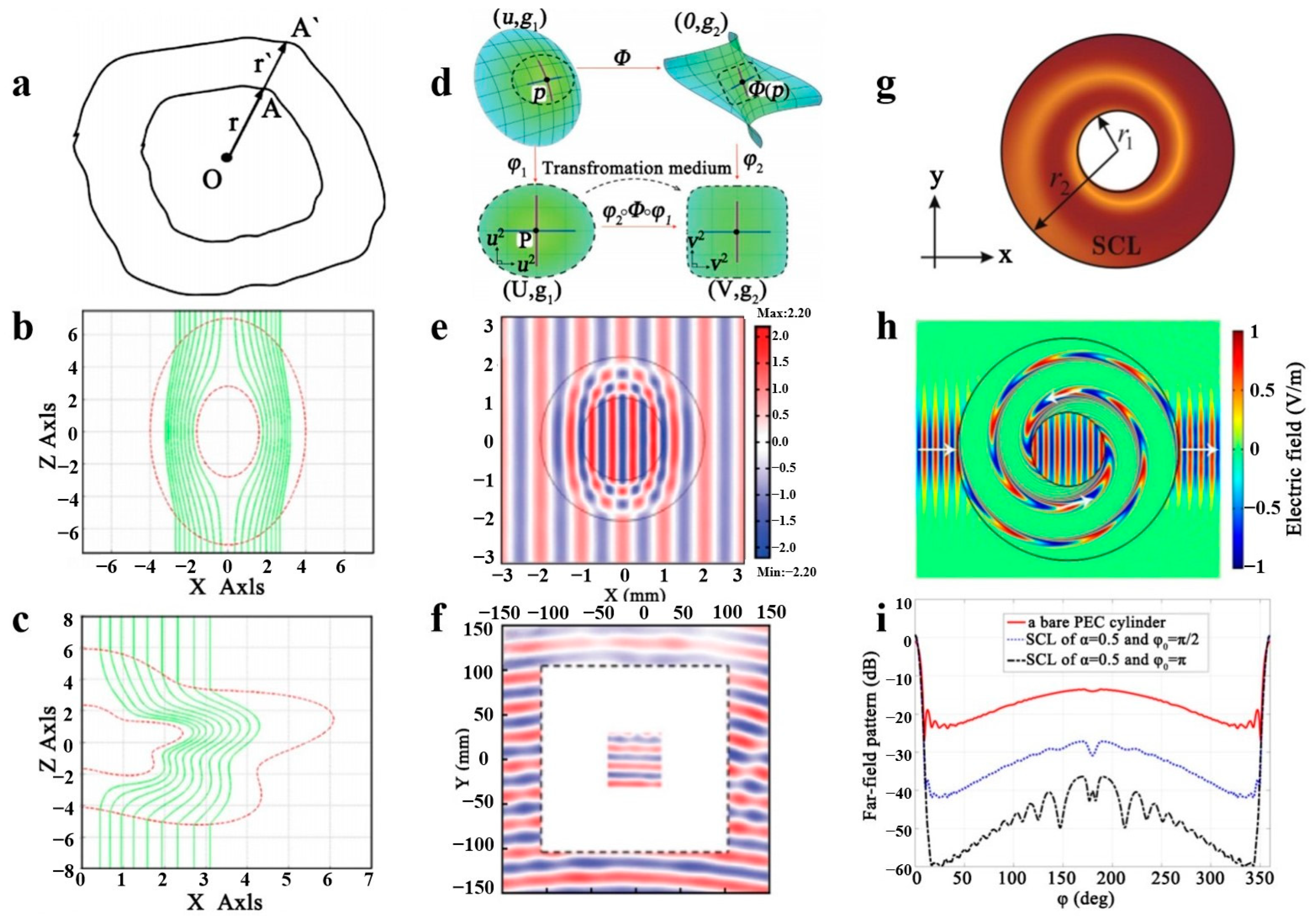
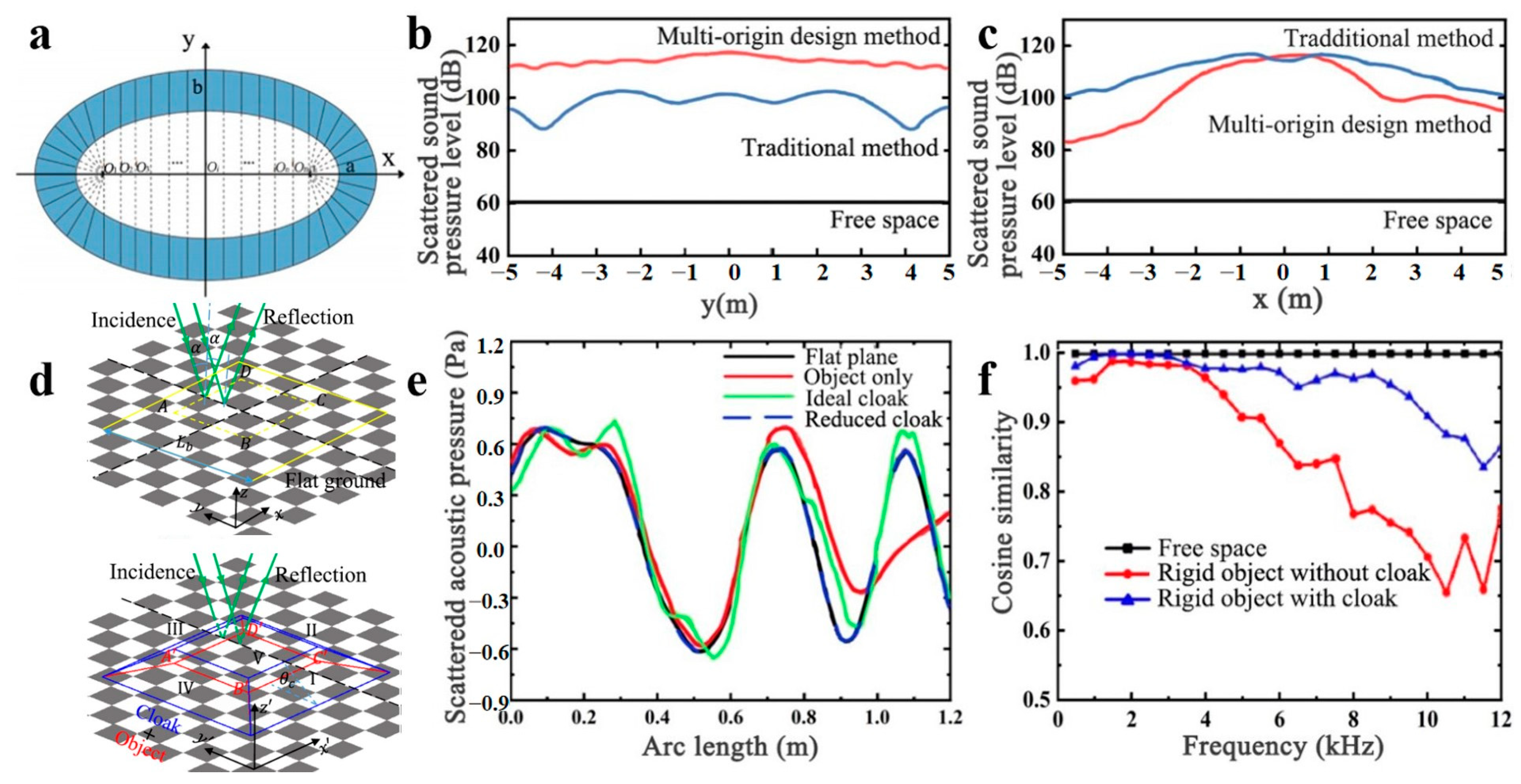

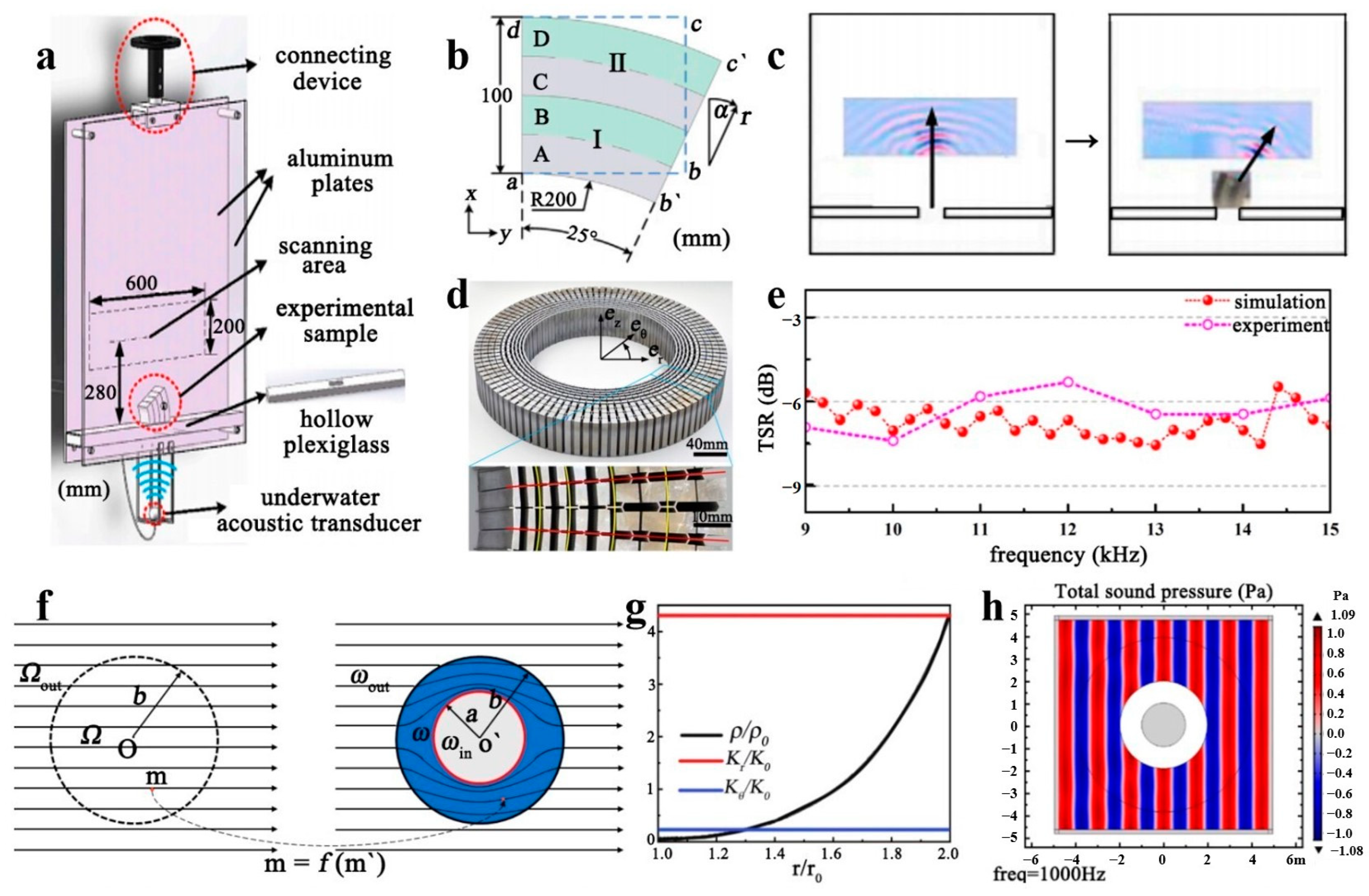

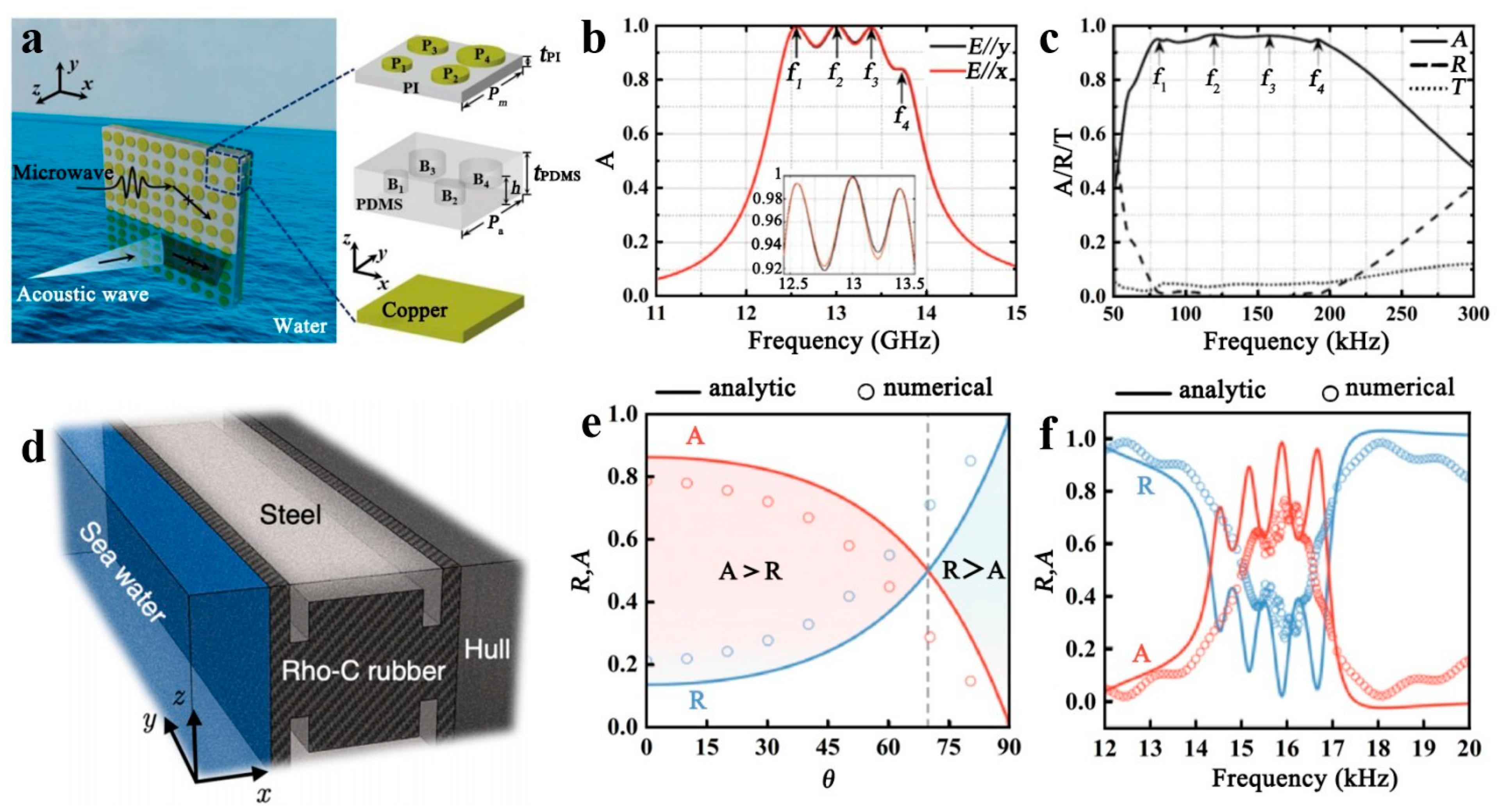



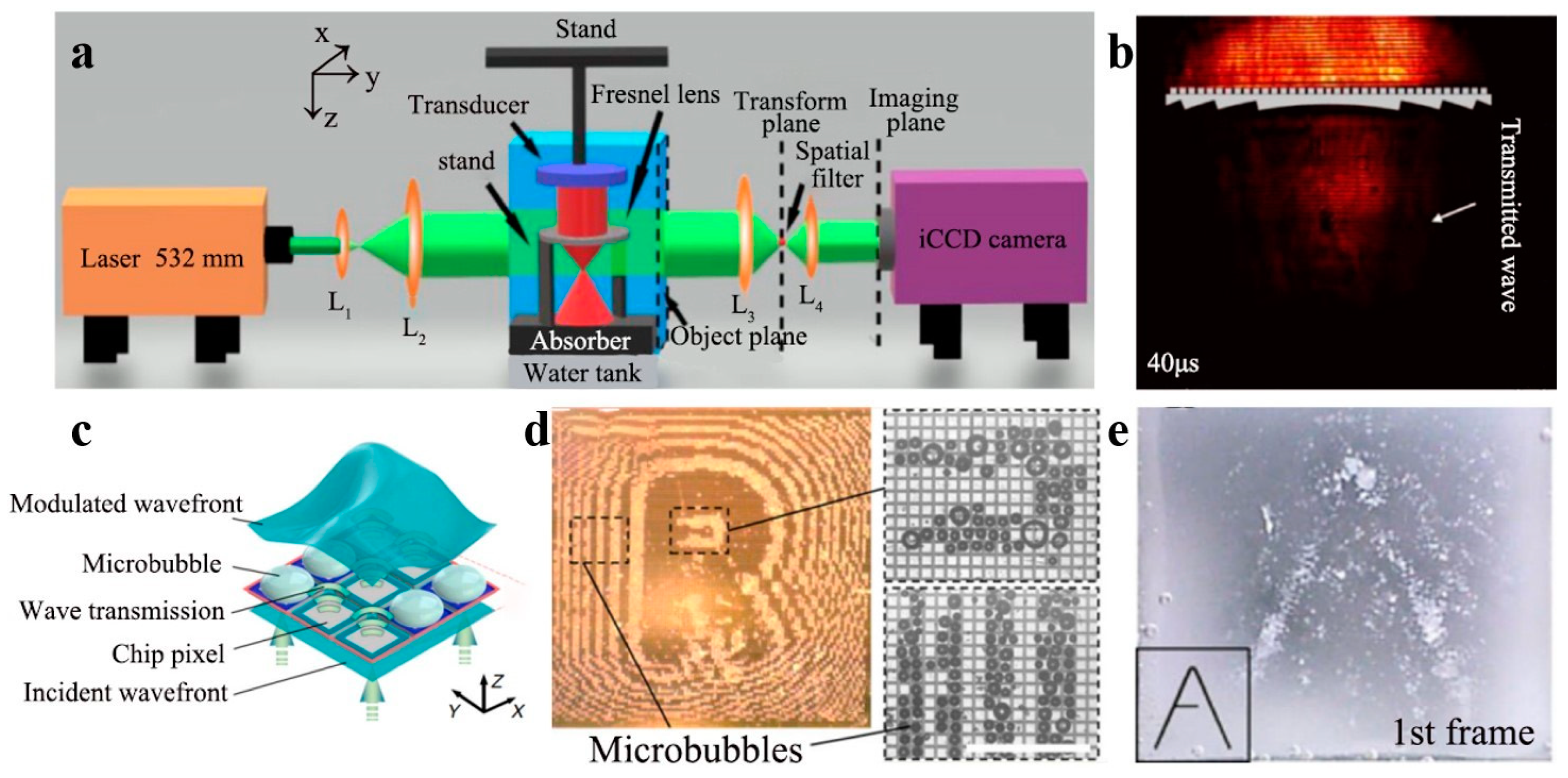
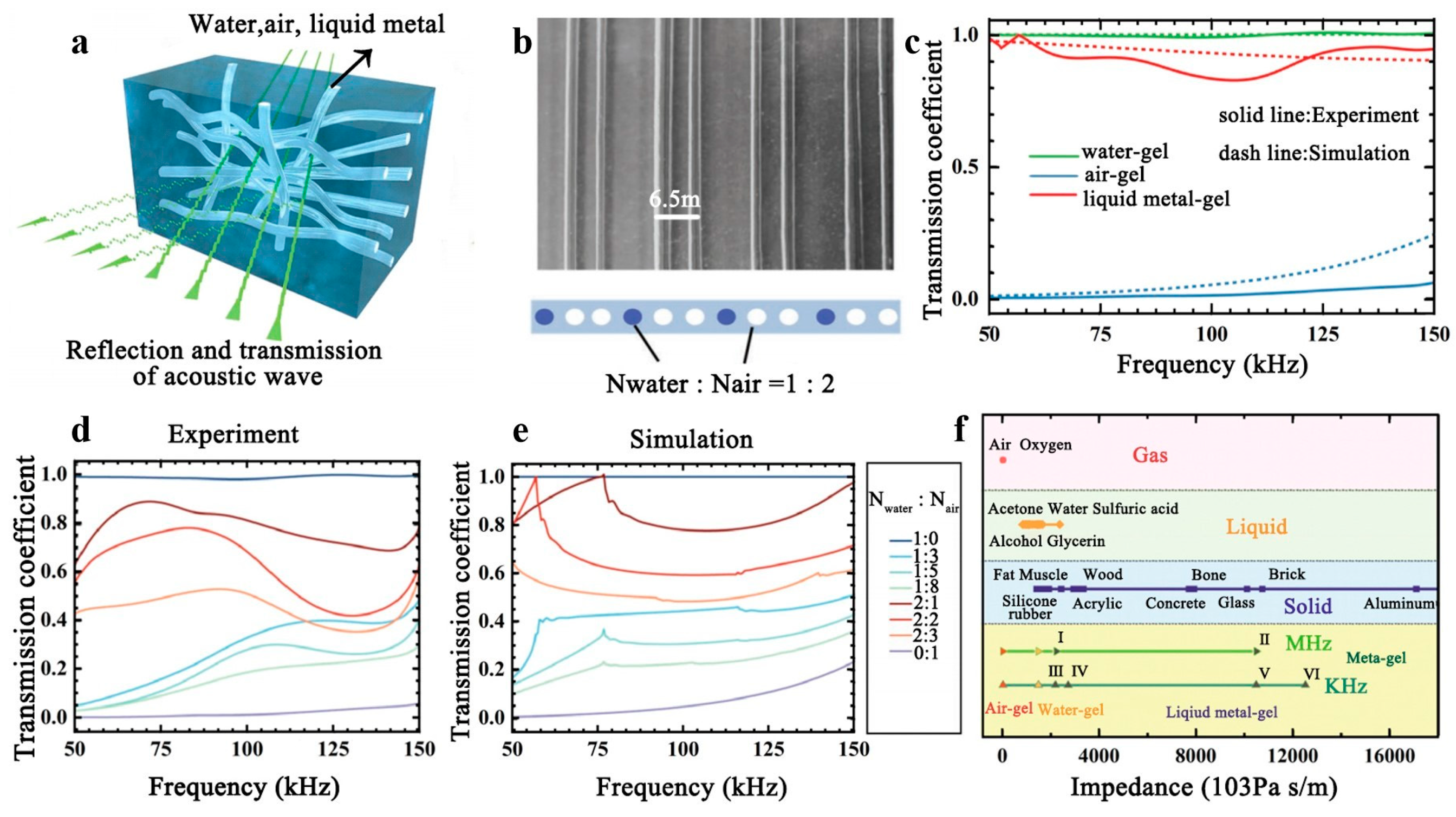
Disclaimer/Publisher’s Note: The statements, opinions and data contained in all publications are solely those of the individual author(s) and contributor(s) and not of MDPI and/or the editor(s). MDPI and/or the editor(s) disclaim responsibility for any injury to people or property resulting from any ideas, methods, instructions or products referred to in the content. |
© 2024 by the authors. Licensee MDPI, Basel, Switzerland. This article is an open access article distributed under the terms and conditions of the Creative Commons Attribution (CC BY) license (https://creativecommons.org/licenses/by/4.0/).
Share and Cite
Deng, Q.; Du, T.; Gomaa, H.; Cheng, Y.; An, C. Methods of Manipulation of Acoustic Radiation Using Metamaterials with a Focus on Polymers: Design and Mechanism Insights. Polymers 2024, 16, 2405. https://doi.org/10.3390/polym16172405
Deng Q, Du T, Gomaa H, Cheng Y, An C. Methods of Manipulation of Acoustic Radiation Using Metamaterials with a Focus on Polymers: Design and Mechanism Insights. Polymers. 2024; 16(17):2405. https://doi.org/10.3390/polym16172405
Chicago/Turabian StyleDeng, Qibo, Tianying Du, Hassanien Gomaa, Yong Cheng, and Cuihua An. 2024. "Methods of Manipulation of Acoustic Radiation Using Metamaterials with a Focus on Polymers: Design and Mechanism Insights" Polymers 16, no. 17: 2405. https://doi.org/10.3390/polym16172405
APA StyleDeng, Q., Du, T., Gomaa, H., Cheng, Y., & An, C. (2024). Methods of Manipulation of Acoustic Radiation Using Metamaterials with a Focus on Polymers: Design and Mechanism Insights. Polymers, 16(17), 2405. https://doi.org/10.3390/polym16172405









